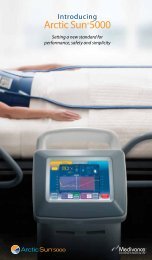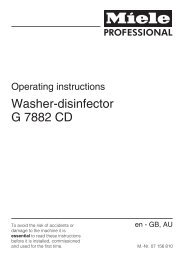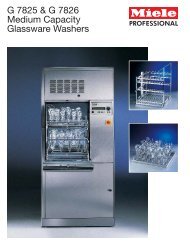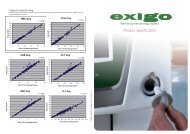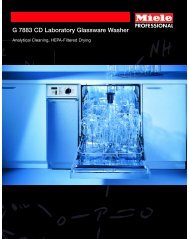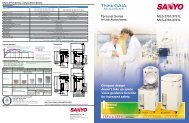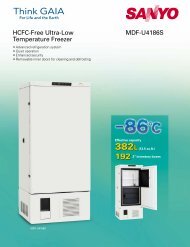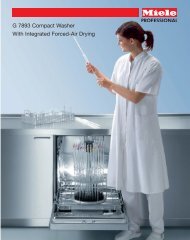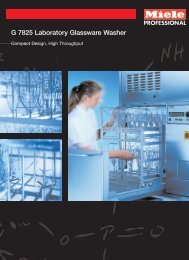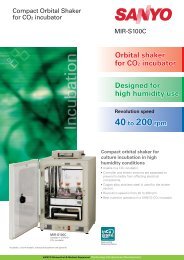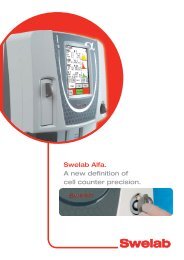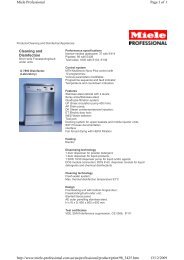G 7881 - Brochure - 2006 final.qxp
G 7881 - Brochure - 2006 final.qxp
G 7881 - Brochure - 2006 final.qxp
You also want an ePaper? Increase the reach of your titles
YUMPU automatically turns print PDFs into web optimized ePapers that Google loves.
Problem Cause Solution<br />
Spotting<br />
Not using water softener<br />
Determine the water hardness from local water authority.<br />
(white residue) Water softener timer not set properly<br />
Set the water softener to appropriate setting using the Operating Instructions handbook.<br />
Not reactivating water softener properly<br />
Replenish reactivation salt as soon as the light comes on according to the instructions in the<br />
Failure to remove gross debris prior to Operating Instructions handbook.<br />
processing<br />
Rust (textured<br />
brown deposits<br />
on instruments)<br />
Chloride-Induced<br />
Pitting (points of<br />
corrosion, with a<br />
small hole in the<br />
middle)<br />
Discoloration<br />
(yellowish or<br />
brownish tint on<br />
instruments)<br />
Unsatisfactory<br />
cleaning results<br />
or white residues<br />
Alkaline detergent in powder<br />
form<br />
Facilitates cleaning process<br />
neodisherTM FA Alkaline detergent in liquid<br />
form<br />
Facilitates cleaning process<br />
Note: Requires optional<br />
automated liquid dispensing<br />
unit<br />
neodisherTM N Neutralizing agent<br />
Restores pH balance to<br />
prevent instrument corrosion<br />
and prolongs machine life<br />
Mielclear Rinse Aid<br />
Protects instruments against<br />
corrosion<br />
Breaks down surface<br />
tension for faster drying<br />
results<br />
Somat Salt<br />
Reactivation Salt<br />
Activates resin used to<br />
soften water; prevents<br />
instrument corrosion<br />
Corrosion from carbon steel instruments<br />
“Fly corrosion” Corrosion spreads from<br />
carbon instruments to stainless steel<br />
instruments<br />
Chlorides in tap water<br />
Chemical attack on instruments from<br />
chlorides or other halide ions<br />
Source for chlorides is often tap-water<br />
or use of improper cleaning agents<br />
Silicates in the water<br />
Not using proper procedure:<br />
Dirty instruments stored in machine<br />
longer than 6 hours<br />
Incorrect detergent dosage<br />
Overloaded machine<br />
Spray arm coupling not engaged<br />
Detergent, neutralizer or rinse aid not<br />
being dispensed<br />
Failure to remove gross debris prior to<br />
processing<br />
CLEANING<br />
AGENTS<br />
Name What It Does Directions for Use & Refilling Tips<br />
neodisherTM MA<br />
Detergent must be manually added to machine<br />
before every wash cycle.<br />
Pour about 3/4 scoop of powder into the dispenser<br />
on the door before each cycle.<br />
The door of the dispenser should not be blocked<br />
by trays or other devices.<br />
Detergent is automatically dispensed when used in<br />
conjunction with optional liquid dispensing unit.<br />
Refill when indicator light comes on.<br />
Indicator light comes on before detergent container<br />
is completely empty.<br />
Neutralizing agent will be automatically dispensed<br />
at proper time during wash cycle.<br />
Refill when indicator light comes on.<br />
Indicator light comes on before neutralizer<br />
container is completely empty.<br />
Mielclear will be automatically dispensed at proper<br />
time during wash cycle.<br />
Unscrew the cap in the door to refill when level<br />
indicator turns light.<br />
Pour Mielclear into storage container in the door<br />
until level indicator darkens.<br />
Set machine according to local water hardness.<br />
When Recharge indicator light turns on, refill with<br />
Reactivation Salt. See Operating Instructions for<br />
further instructions.<br />
Run the Rinse Cycle immediately after refilling<br />
water softener to be sure all salt is dissolved.<br />
TROUBLESHOOTING GUIDE<br />
Too much as well as too little detergent may have<br />
adverse cleaning effects.<br />
If detergent container becomes completely empty<br />
and air fills the pick-up tubes, it will be necessary to<br />
prime the pumps.<br />
If neutralizing agent container becomes completely<br />
empty and air fills the pick-up tubes, it will be<br />
necessary to prime the pumps.<br />
Make sure that any spillage is wiped off the door<br />
after refilling or run the Rinse cycle immediately<br />
after refilling.<br />
Consumption of salt is dependent upon local water<br />
hardness.<br />
Do not process carbon steel instruments in the Miele dental washer disinfector.<br />
Separate stainless & carbon instruments throughout the cleaning and sterilization process.<br />
Treat instruments with neodisher TM IR.<br />
Have water tested for chlorides. It may be necessary to get an external water purification<br />
system if chloride level exceeds 50 ppm.<br />
Have water tested for chlorides. It may be necessary to get an external water purification<br />
system if chloride level exceeds 50 ppm.<br />
Use only Miele approved cleaning solutions.<br />
Remove corrosion with neodisher TM IR or it may be necessary to replace instruments.<br />
Treat instruments and the Miele dental washer disinfector wash chamber with<br />
neodisher TM IS.<br />
Do not allow dirty instruments to sit for more than 6 hours.<br />
Check the dosage of the detergent and adjust if necessary. Too little as well as too much<br />
detergent may have adverse cleaning effects.<br />
Place instruments into machine allowing water and detergent to touch every surface.<br />
Do not overload. Make sure the spray arm can easily rotate and is not blocked by any devices.<br />
There should be a tight fit between the coupling and the water inlet connector at the<br />
top of the chamber. Follow directions in the Operating Instructions handbook.<br />
Check dispensing, be sure rinse aid dispenser is filled<br />
Remove gross debris<br />
QUESTIONS? Call 1-800-991-9380 or email: dental@mieleusa.com<br />
©<strong>2006</strong> Miele, Inc. B999649 09/06



